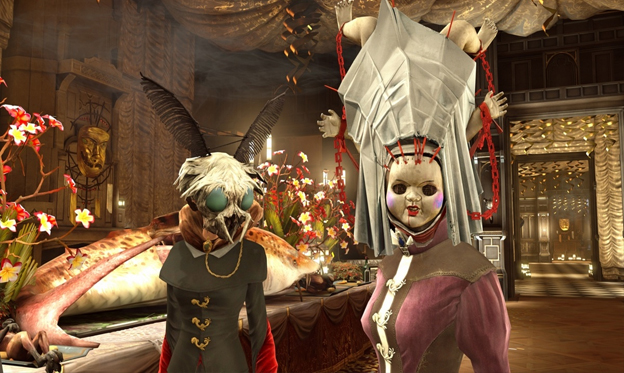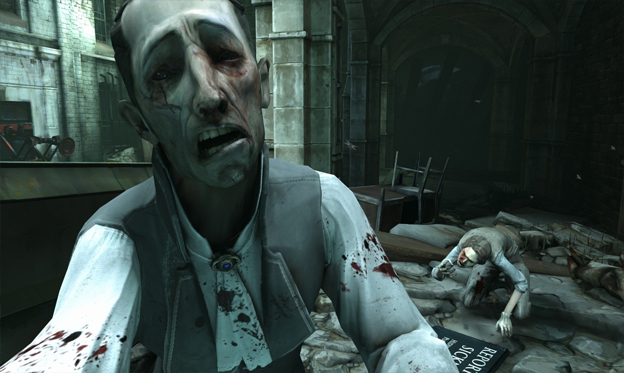What Do You Do With A Drunken Whaler?
What do you do with a drunken whaler? The question posed in Dishonored’s version of the classic sea chantey could prove relevant should said whaler be guarding an important doorway. Do you use your blink power to traverse from the balcony across the street to the window ledge above him, shoot a sleeping dart from your crossbow to render him unconscious, then stealthily lay his body in a nearby alcove so it won’t be seen by any passing guards? Or do you attach a sticky grenade to a rat, stop time, possess the rat, run it to the sailor, bail out of the possession, hide around the corner, restart time, and listen as all Hell breaks loose?
The path you choose to solve the door guard problem is about more than how creative or sadistic you’re feeling at the time. It’s about how you feel about the beautiful, corrupt world in which the game is based. The game places the player in the shoes of Corvo Attano, a powerful noble who has been framed for the worst crime imaginable for a man of his station. Rescued from prison by a group of rebels, Corvo becomes an assassin in an attempt to reclaim his empire from usurpers, exact revenge on the people who wronged him, or both. Along the way, he attracts the attention of the mysterious Outsider, a powerful otherworldly being who finds him fascinating and grants him supernatural powers.

Although the entirety of Dishonored takes place in the city of Dunwall, material that the player finds throughout the game paints a picture of a fascinating world experiencing an alternative Industrial Revolution powered by whale oil. Dunwall itself is a great setting, and Corvo will plumb its literal and figurative heights and depths during his quest. Not only is there the contrast of the opulent rich and the miserable poor, Corvo has the ever-increasing totalitarian government crackdown, supported by oil-powered mechanical monstrosities, to contend with. Oh, and did I mention the rat plague that has caused an untold number of deaths and condemned large portions of the city? Or the fact that the Outsider’s touch frequently seems to lead to madness? The player has the opportunity to uncover many secrets about Dunwall and the larger empire of which it is a part during the game, but many mysteries remain unsolved, leaving us wanting more.
It doesn’t hurt that Dunwall is beautifully realized, with graphics that evoke dark industrial realism while also possessing a distinctive style. The use of color in the game is brilliant, as the game avoids both garishness and the dull monochrome look found in many so-called “dark” settings. Instead, a true-to-life palette allows the player to move seamlessly between industrial warehouses, opulent mansions, and grimy sewers, all the while admiring the meticulous work put into establishing the setting and bringing the world to life. The sound design supports the setting and gameplay well, with strongly-voiced characters conversing with each other around every corner, and sound effects that assist the player in staying hidden and tracking targets. My only complaint is that there’s no option to turn on subtitles, which can make life difficult for anybody playing under less-than-optimum conditions.

I could rave about Dishonored’s setting for ages, but let’s get down to the gameplay. Corvo starts off the game with a blade in his right hand and a pistol in his left. As he befriends one of Dunwall’s foremost natural philosophers (read: mad-scientist and inventor) and grows closer to the Outsider, Corvo will gain a wide variety of gadgets and powers that he’s able to equip in his left hand. From a crossbow with various kinds of darts to the ability to possess animals and even people, Corvo’s powers and contraptions offer plenty of lethal and non-lethal ways to traverse levels and dispatch his foes. This is important, since direct combat is quite simplistic and would be quite boring to use throughout the game. While it’s possible for a skilled player to treat Dishonored like a pure action game, attacking everything with sword and pistol brandished, that would be missing most of the fun.
Combining contraptions and powers rewards inventive players with even more options. The blink and time-stop powers are particularly useful for setting up kills as well as for avoiding enemies without being seen. Experimentation is encouraged, especially with various ways to use the game’s environment and with the fact that whale oil is highly explosive. With guards and crazy security devices everywhere, getting through the levels is a fun puzzle, especially if the player hopes to do so largely undetected (something the game rewards). Corvo may be powerful, but discretion is usually the better part of valor in Dishonored, and it’s highly satisfying to peel away security layers like an onion while working toward the goal at the center of the level.
Corvo’s ultimate goal in most of the game’s missions is to dispatch a particular assassination target. How Corvo reaches the target and whether to use lethal force are completely up to the player. The city of Dunwall is a virtual playground for a powerful assassin like Corvo, with multiple paths available everywhere in a relatively free-form design. Exploring the levels carefully generally results in side quests that can give the player more options or information, as well as lots of treasure that is immediately converted to gold, which can be used back at the rebel base in order to purchase equipment and upgrades. The game’s tooltips (which can be thoroughly customized to give the player the desired amount of direction) constantly remind players to play their own way, and a two trips through a single mission can be vastly different depending on the route that the player takes.
With Corvo’s impressive arsenal, it’s quite tempting to go to town on Dunwall’s citizenry, especially when so many of those fine citizens are determined to slice, dice, explode, or even gnaw him to death. Early on, though, the game warns the player that a high body count will lead to a larger number of plague rats, deranged plague victims (known as Weepers for the blood that leaks from their eyes), and a darker outcome to the story. Dishonored offers a great deal of freedom of choice without having freedom from consequence, a system I personally find brilliant.

There is no real goody-two-shoes approach to Dishonored, however. A player determined to keep Corvo from descending into rage and corruption will still need to work with various unsavory characters, and will also discover that many non-lethal methods of neutralizing a target are even more cruel than a simple death might have been. It doesn’t help that one of his major tools, a “gift” from the Outsider, is a beating semi-clockwork human heart that shows him the way to the Outsider’s runes and bone charms, along with whispering secrets to him when pointed at another character or at the environment. I couldn’t resist learning every major character’s secrets, but holding the thing becomes increasingly disturbing as you learn more about what, and who, it might actually be.
It’s interesting to note that with the huge amount of choice available in completing missions, Corvo almost never utilizes his conversational skills. He’s completely unvoiced and has only very occasional dialogue choices, while everyone around him is quite willing to talk his ear off. It’s quite disconcerting at first, but soon it simply feels like Corvo is keeping his own counsel, expressing himself through the things he does rather than wasting words during a time when urgent action is required.
For those worried about Dishonored’s open-ended level design combined with Bethesda’s reputation for releasing buggy games, fear not. Playing Dishonored on the PC was a refreshingly bug-free experience for me. I never crashed or experienced any odd visual glitches. Despite exploring the levels thoroughly and cramming myself into some tight spots while hiding from guards, I never fell through a level or got stuck someplace I couldn’t get out of. Enemy creatures and characters, though sometimes erring on the side of generosity in terms of being able to detect my movements, displayed solid A.I. and never got stuck in the levels or behaved erratically. While the most creative players are sure to find ways to “break” the game, it’s quite solid and shouldn’t need much, if any, patching after release.
No game is perfect, and Dishonored certainly has its flaws. It’s fairly easy on the “normal” difficulty setting and veteran stealth gamers will probably want to set the difficulty higher. The first-person viewpoint can make jumps a bit difficult to judge sometimes, though the blink power provides a cheap and easy way to traverse levels instead. Finally, the later levels aren’t quite as captivating as the earlier ones. One late-game level is a bit of a slog, though it has some great segments along the way, and the final level is a bit anticlimactic. Still, that level led me to a satisfying conclusion to the story in my low-chaos playthrough. It’s entirely possible that the level is more interesting and challenging for players who have taken a more lethal approach to the game.

As a full piece, however, Dishonored is incredible both as a game and as a work of art. Fun to play, intriguing to explore, beautiful to look at, and emotionally evocative, it’s a game that simply must be experienced. While it offers plenty of gory action for those who are interested in taking that route, its greatest gift is to deliberate, thoughtful players who enjoy stealth-based games with quality settings and meaningful moral choices.
Dishonored made me feel like a person struggling to retain the things that were important to me in a world gone mad. It goes beyond “role-playing” to challenge players to draw their own personal moral line in the sand, but does so without being preachy or judgmental. Is it really best not to kill anybody , or are there people who are evil enough to deserve death, should you have the power to mete it out? It’s messy and thought-provoking, just like the real world… or at least a real world in which you have the power to possess rat swarms and perform impressive “death from above” leaping assassinations. Is it a world worth saving? That’s exactly what Dishonored wants each player to decide, and have a wickedly good time in doing so.
RATING OUT OF 5 RATING DESCRIPTION 5.0 Graphics
Dishonored boasts a unique style, incredibly detailed world, and a flawless use of color. 4.4 Control
Though straight-up combat is a simple affair, it’s also not the point. Using Corvo’s many gadgets and powers is simple and fun. 4.5 Music / Sound FX / Voice Acting
The sound design perfectly enhances Dishonored’s stealth-based gameplay. 5.0 Play Value
There are tons of things to explore and discover in the game, plus multiple endings depending on the player’s actions. 5.0 Overall Rating – The Best
Not an average. See Rating legend below for a final score breakdown.
| Review Rating Legend | |||
|---|---|---|---|
| 0.1 – 1.9 = Avoid | 2.5 – 2.9 = Average | 3.5 – 3.9 = Good | 4.5 – 4.9 = Must Buy |
| 2.0 – 2.4 = Poor | 3.0 – 3.4 = Fair | 4.0 – 4.4 = Great | 5.0 = The Best |
Game Features:
